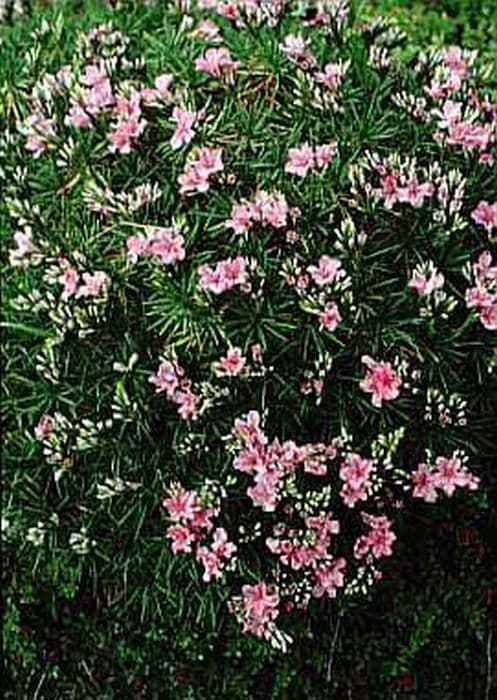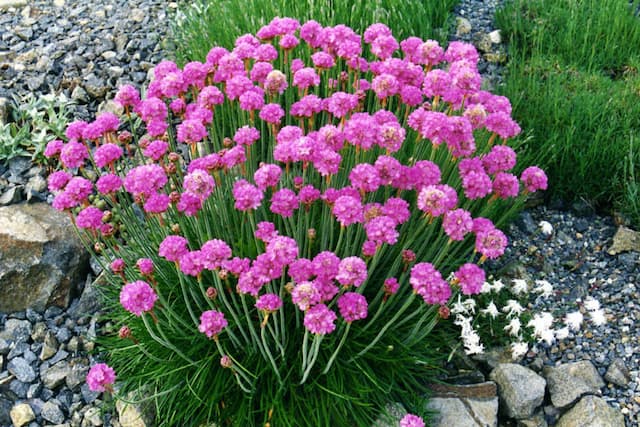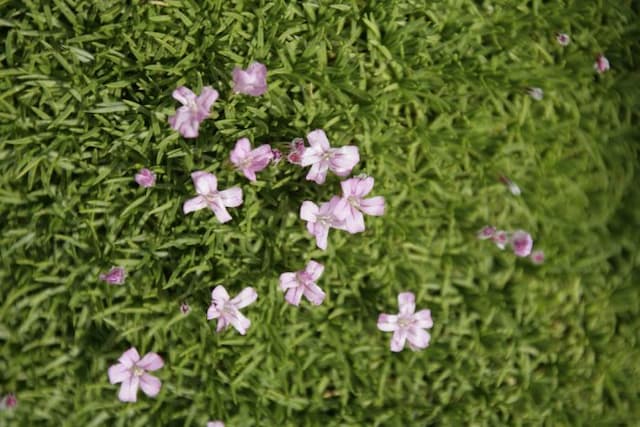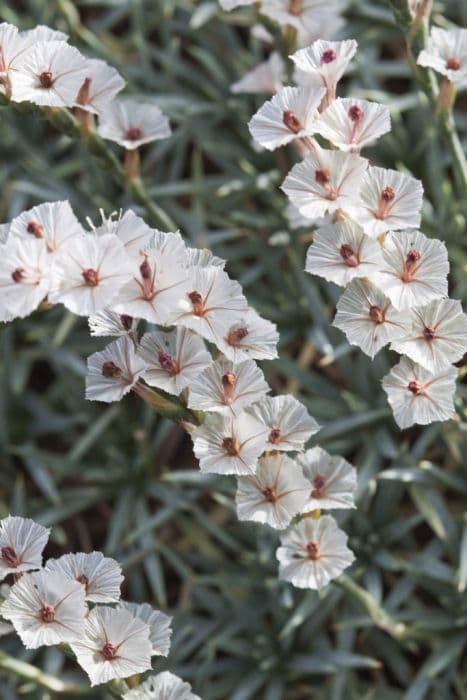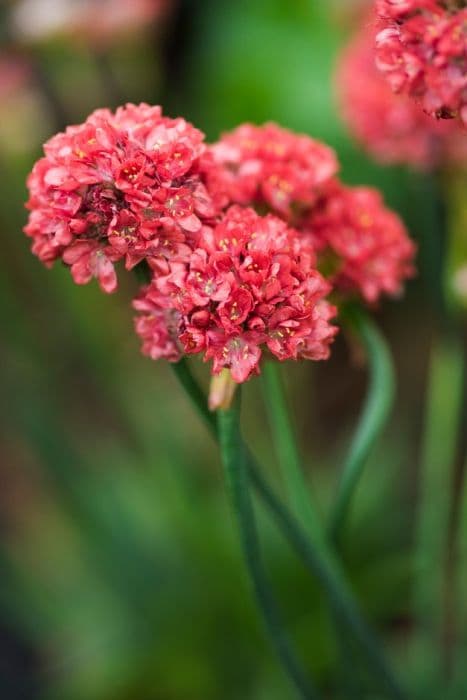White Cape Leadwort Plumbago auriculata f. alba

ABOUT
The plant commonly known as White Leadwort is an attractive shrub that boasts clusters of beautiful white flowers. Each flower is characterized by a tubular shape that fans out into five petals, resembling a bit like a star. The petals are a pure, creamy white, and they can often appear to have a slightly iridescent quality. In the center of these flowers, there’s often a hint of pale yellow or green, where the reproductive parts of the flower are located. The foliage of White Leadwort is also noteworthy. The leaves are a shiny, rich green color, and they have an oval shape with a pointed tip. The edges of the leaves are smooth, and they seem to almost glimmer in the sunlight due to their glossy texture. They are arranged neatly along the stems, creating a dense, lush appearance. The stems themselves are slender and flexible, and they may have a tendency to sprawl gently. This adds a casual, relaxed vibe to the overall look of the plant, making it a popular choice for gardeners looking to create a peaceful and serene garden space. The combination of the elegant white flowers and the glossy green leaves makes White Leadwort a striking addition to any landscape, where it contributes a sense of tranquility and purity with its delicate blooms and verdant foliage.
About this plant
 Names
NamesFamily
Plumbaginaceae
Synonyms
White Leadwort, White Plumbago, Cape Leadwort, White Cape Plumbago
Common names
Plumbago capensis Thunb., Plumbago capensis var. alba Moldenke.
 Toxicity
ToxicityTo humans
Cape Leadwort, also known as Plumbago auriculata f. alba, is not commonly listed as a highly toxic plant to humans. However, it is always recommended to avoid ingesting plants that are not known to be edible as they can cause adverse reactions in some individuals. If ingested in significant quantities, the plant may cause mild stomach upset, nausea or vomiting. Handling the plant might also result in skin irritation due to the presence of a sticky sap.
To pets
Cape Leadwort is also not commonly known to be highly toxic to pets. However, as with humans, ingestion of non-edible plants by pets should be avoided since it could potentially cause mild gastrointestinal upset such as vomiting or diarrhea. Also, the sap might cause skin irritation, and care should be taken to ensure that pets do not come into contact with the plant excessively. If a pet does ingest a part of the plant and shows signs of distress, it is advisable to consult a veterinarian.
 Characteristics
CharacteristicsLife cycle
Perennials
Foliage type
Evergreen
Color of leaves
Green
Flower color
White
Height
3-5 feet (0.91-1.52 meters)
Spread
3-5 feet (0.91-1.52 meters)
Plant type
Shrub
Hardiness zones
9
Native area
South Africa
Benefits
 General Benefits
General Benefits- Ornamental Value: White Cape Leadwort, or Plumbago auriculata f. alba, features attractive white flowers that enhance the aesthetic appeal of gardens and landscapes.
- Low Maintenance: It is a hardy plant that requires minimal care once established, making it ideal for gardeners of all skill levels.
- Drought Tolerance: This plant is drought-tolerant, thus it can survive with little water, suitable for xeriscaping and arid environments.
- Attracts Wildlife: The flowers of White Cape Leadwort attract butterflies and other beneficial insects, promoting biodiversity.
- Fast Growth: It has a rapid growth rate, providing quick coverage for trellises, fences, and other garden structures.
- Soil Adaptability: This plant can thrive in a variety of soil types, from sandy to loamy, as long as there is good drainage.
- Versatile Usage: White Cape Leadwort can be used in multiple garden settings, such as borders, containers, and as ground cover.
 Medical Properties
Medical Properties- Antimicrobial: The plant has been traditionally used for its antimicrobial properties against various pathogens.
- Anti-inflammatory: Extracts of Plumbago auriculata f. alba may possess anti-inflammatory effects.
- Analgesic: The plant has been used for its potential analgesic effects, which may help alleviate pain.
- Wound healing: Some practices use the plant for its claimed abilities to promote wound healing.
- Antifungal: It may have antifungal properties that can help in treating fungal infections.
- Antiplasmodial: There are claims that the plant has antiplasmodial activity, which would be beneficial in fighting malaria.
- Antioxidant: The plant is suggested to have antioxidant properties, which may help in preventing oxidative stress-related diseases.
 Air-purifying Qualities
Air-purifying QualitiesThis plant is not specifically known for air purifying qualities.
 Other Uses
Other Uses- Landscape artist's dye: The white flowers of Plumbago auriculata f. alba can be used to create a natural dye for canvas or paper, adding a unique touch to artwork.
- Butterfly attraction: Gardeners often plant white plumbago to attract butterflies, which are drawn to its sweet nectar and enhance the garden's biodiversity.
- Ink production: The pigments from the flowers can be used in the traditional preparation of inks for writing or drawing.
- Artistic inspiration: Due to its attractive blooms, white plumbago often serves as a subject for botanical illustration and nature photography.
- Wedding décor: The pure white flowers can be used in wedding ceremonies as part of bouquets or table arrangements for a natural aesthetic.
- Creative crafts: Dried plumbago flowers are sometimes incorporated into homemade paper or used in potpourri mixes.
- Educational tool: Because of its easy cultivation, it may be grown in schools for teaching botany or horticulture.
- Soil erosion control: Plumbago is good for stabilizing banks and slopes in the garden, thanks to its extensive root system.
- Livestock feed: In some regions, the leaves of plumbago are occasionally fed to livestock, though its palatability varies and should be approached with caution.
- Symbolic planting: Plumbago auriculata f. alba is sometimes planted in gardens to symbolize purity and spiritual connection due to its white flowers.
Interesting Facts
 Feng Shui
Feng ShuiThe White Plumbago is not used in Feng Shui practice.
 Zodiac Sign Compitability
Zodiac Sign CompitabilityThe White Plumbago is not used in astrology practice.
 Plant Symbolism
Plant Symbolism- Persistance: Plumbago auriculata f. alba is known for its vigorous growth and ability to spread, symbolizing persistence and the determination to overcome obstacles.
- True Love: The plant's flowers, with their pure white color, are often associated with the sincerity and purity of true love.
- New Beginnings: As a plant that can bloom throughout the year, it signifies new beginnings and the endless opportunities each day brings.
- Peace: The soothing hue of its flowers is often connected with tranquility and peace, promoting a calming environment.
 Water
WaterThe White Cape Leadwort should be watered thoroughly once the top inch of soil feels dry to the touch. In general, this may mean watering approximately once a week, but frequency can vary with environmental conditions. When watering, aim to use about half a gallon for smaller plants and up to one and a half gallons for larger shrubs to ensure the root zone is adequately moistened. During the hotter summer months, the plant may require more frequent watering. Always allow excess water to drain away to prevent root rot, and reduce watering in the winter when the plant is not actively growing.
 Light
LightWhite Cape Leadwort thrives in full sun to partial shade. The best spot for this plant is one where it can receive at least six hours of direct sunlight daily. If indoors, a south-facing window is ideal to provide bright light. However, in extremely hot climates, some afternoon shade may be beneficial to prevent leaf scorch.
 Temperature
TemperatureWhite Cape Leadwort enjoys warm temperatures and can typically survive in a temperature range of 40°F to 100°F. The ideal temperature for promoting healthy growth is between 60°F and 85°F. It's important to protect the plant from frost, as temperatures below 40°F can damage or kill the plant.
 Pruning
PruningPruning White Cape Leadwort should be done to maintain shape, encourage bushier growth, and remove spent flowers or damaged branches. Prune in late winter or early spring before new growth begins. This plant can be pruned quite hard if necessary; however, regular, light pruning is typically sufficient to keep the plant looking its best.
 Cleaning
CleaningAs needed
 Soil
SoilCape Leadwort (White Plumbago) thrives in a soil mix that is well-draining with a pH ranging from 5.5 to 6.5. A good mixture would be two parts loam, one part peat or compost, and one part sharp sand or perlite to ensure proper drainage.
 Repotting
RepottingCape Leadwort should be repotted every 2-3 years to prevent root-bound conditions and to refresh the soil mix, ensuring healthy growth and abundant flowering.
 Humidity & Misting
Humidity & MistingCape Leadwort prefers moderate humidity levels, but it is quite adaptable and can tolerate the humidity typical of most homes. Aim for a range between 40-50% for optimal growth.
 Suitable locations
Suitable locationsIndoor
Place Cape Leadwort in a sunny spot.
Outdoor
Grow in full sun to light shade.
Hardiness zone
8-11 USDA
 Life cycle
Life cyclePlumbago auriculata f. alba, commonly known as white cape leadwort, begins its life cycle as a seed, which germinates in moist, well-drained soil with adequate warmth and light. Once the seedling emerges, it enters into a vegetative growth phase, developing a robust root system and producing elongated stems with glossy, evergreen leaves. As it matures, the white cape leadwort enters a flowering stage, where it produces clusters of white flowers that are attractive to butterflies and other pollinators. After pollination, the flowers develop into small, sticky fruits containing seeds, which can be dispersed by animals or by adhering to passing objects. The plant can also spread vegetatively through its creeping stems that take root at the nodes when they touch the soil. White cape leadwort maintains a perennial lifecycle in suitable climates but may act as an annual in regions with cold winters.
 Propogation
PropogationPropogation time
Spring to Summer
For Cape Leadwort, also known as Plumbago auriculata f. alba, the most popular method of propagation is by semi-hardwood cuttings. This process typically takes place during late spring through early fall, when the plant is actively growing and the stems are mature, yet still flexible. Cuttings should be about 4 to 6 inches (10 to 15 centimeters) long, with the lower leaves removed, and the cut made just below a node. It's advisable to dip the cut end into a rooting hormone to encourage root growth and plant the cutting in a well-draining soil mix. Maintaining a warm and humid environment by covering the potted cuttings with a plastic bag can accelerate root development. Cuttings usually root within a few weeks, after which they can be transferred to individual pots and gradually acclimatized to outdoor conditions before being planted in their final location.


